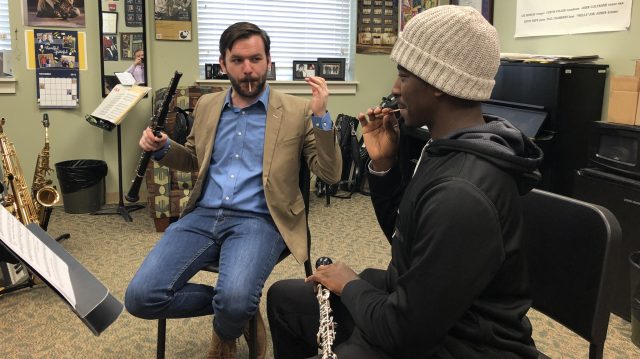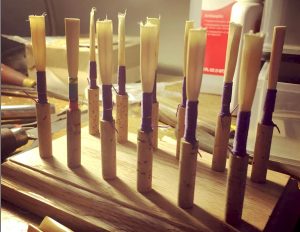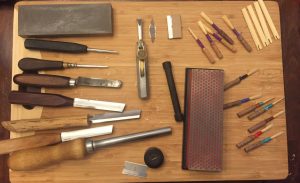
Music instructor Austin Smith works on double-reed methods with Ole Miss music student Michael Ivy. Photo courtesy Adam Estes
OXFORD, Miss. – When Austin Smith whittled wood as a child, little did he know that it would turn into a passion that would complement his journey as a professional musician.
“When I was a kid, I was obsessed with working with wood and whittling sticks, so I think some of that obsession transferred to making reeds,” the University of Mississippi music instructor said. “I spent quite a lot of time working on it at an early age.”
Smith, who joined the faculty of the Department of Music last summer, was a talented oboist from an early age, and when he decided he was serious enough to continue his training in college as a performance major, his teacher began showing him how to make reeds.
“I started learning how to make reeds in early high school and was independently making my own reeds by my junior year,” he recalled. “Any reed instrument player has the option to make their own reeds.
“With single-reed instruments like clarinet or saxophone, reed making is much less common because machine-made reeds can be very good – usually just as good or better than making them by hand. Oboe and bassoon reeds, or double reeds, are much more complicated.”
While some performers use reeds made by a machine, they are typically inconsistent and of poorer quality than handmade.
“The technology isn’t there yet,” Smith said. “That’s why it’s more common for double-reed players to hand make their reeds or buy handmade reeds.”
Smith has taken his interest and skill in making reeds and turned it into a secondary career.
“I’ve been making reeds for Innoledy, a high-end woodwind instrument dealer based in Manhattan, for the past 11 years,” he said. “I started making reeds professionally just after my freshman year in college.
“I had been making reeds for my teacher at the time, and he referred me to Innoledy when they were looking to expand into dealing oboe reeds. Since then, I have been very lucky to have given many reed-making master classes to students and professionals from all over the world.”

Partially finished reeds dry on Austin Smith’s workbench after the first day of scraping. Submitted photo
All reed players use the same type of cane, but larger reeds – such as those used by bass clarinet or baritone saxophone – come from lower on the stalk of cane, where the diameter is wider. The oboe, being smaller, uses cane from a higher part of the stalk than other reed instruments.
“Reed cane can be somewhat compared to different wine vintages,” Smith said. “Some years are better than others, and certain players prefer cane grown in different regions of the world because of the various qualities it can add to their tone.
“I experiment with different canes, but my two go-to brands come from France – which is the most popular – and China. Both of these types of cane give me two very distinct qualities in my reeds that I like for different performance situations.”
The incredible thinness of the reed is what makes it so sensitive.
“At the very tip, my reeds tend to be around 0.05 millimeter to 0.03 millimeter,” Smith said. “When you consider you’re working with an organic material that’s that thin – basically a whittled down piece of grass – weather can be a huge factor in how your reeds change.”
Factors such as temperature, humidity and elevation can have a huge impact on a reed’s quality, he said.
“A reed can change from being a very good reed the day you made it, to a very bad reed the next day,” Smith said, explaining why professional oboists often carry dozens of reeds in various stages, “because you never know what’s going to work on that particular day and in that particular space.
“That’s why if you see me walking around school with five reeds in my mouth, it’s not because I’m a crazy person; it’s because I’m not sure what reed will be the right fit for the room I’m rehearsing or performing in that day.”
When learning to make reeds, patience and practice are critical because beginners will make many bad reeds before honing their skills enough to make anything close to “performance ready,” he said.

Austin Smith, an accomplished performer on oboe, has forged a secondary career as a master reed-maker. He produces reeds for Innoledy, a high-end woodwind instrument dealer in New York. Submitted photo
“Even as a professional oboist and reed-maker, I still make bad reeds, and there are still occasions where I have to play a rehearsal or performance on a reed I don’t like,” he continued. “I always tell my students that the best reed-makers/oboists are the ones who can fool everyone into thinking they’re always playing good reeds – even if it means forcing a bad reed to sound good!”
This is part of what Smith wants to teach Ole Miss woodwind students. He’s conducted a reed clinic with Adam Estes, who teaches saxophone and bassoon, and also has worked with individual students.
Reed making can be challenging for some musicians in part because of the very different skill set required.
“One unique challenge oboists face is that so much of our performance lives depend on this strange craft that really has nothing to do with music at all,” Smith said. “I think this is why so many oboists can have a tough time making reeds; it requires a totally different type of thinking than making music.
“At the same time, if you’re able to master reed making, it can serve as a valuable tool to really aid music making. Because we’re forced to invest so much time in creating our own unique sound, we have the ability to alter that sound at a moment’s notice in order to adapt to the situation – a luxury most other acoustic instruments do not have.”
At a clinic at the University of Tennessee at Martin, Smith taught future music educators, many of whom have little experience with double-reed instruments such as oboe or bassoon, but who may end up teaching beginning double-reed students in an orchestra or band class.
“Many institutions only offer a single course in woodwind methods, so many future educators are left wholly unprepared to deal with the specificities of double-reed instruments,” said Douglas Owens, who hosted the clinic. “Reed selection is a tremendously important aspect of playing those instruments with good characteristic tone and with accurate intonation, and is often addressed only superficially at best.
“Austin provided invaluable information without succumbing to the specialist’s temptation of ‘digging in the weeds’ about a favorite topic. As a performer, Austin’s evenness and consistency of tone quality and impeccable control of his instrument left me inspired.”
UTM students also were impressed. Matthew Wilson, a rising senior considering graduate study in oboe, called Smith a “very concise teacher and an excellent reed-maker.”
“He’s focused on specific details, such as how the stage will sound in contrast to the practice room,” Wilson said. “He gave me good advice on my oral setup for the reed.”
But Smith is not just a great teacher and a master reed-maker; he is also an accomplished and in-demand oboist. Despite limitations imposed by the COVID-19 pandemic, he has remained an active performer.
Smith just finished a recording project for Queen City Opera that will be coming out later in July. He’s also performing online in the world premiere of a piece with the Maryland Chamber Winds.
“For me personally, I’ve really been trying to get back to the basics – lots of long tones, scales and arpeggios, things that make me feel really in control of the instrument when I’m playing,” he said. “I’ve also been working on a lot of solo oboe music that I’ve always wanted to learn but haven’t had the time, such as the Heinz Holliger Oboe Sonata and a few pieces by Gilles Silvestrini.”
